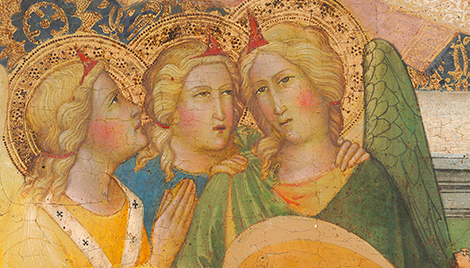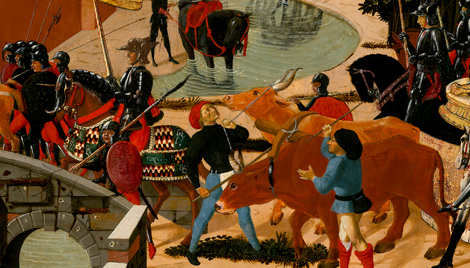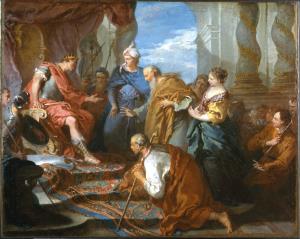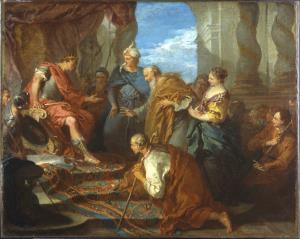Joseph Presenting His Father and His Brothers to the Pharaoh
Joseph Presenting His Father and His Brothers to the Pharaoh
- Artist
- François Boucher
- Artist Dates
- 1703-1770
- Artist Nationality
- French
- Title
- Joseph Presenting His Father and His Brothers to the Pharaoh
- Date
- c. 1723
- Medium
- oil on canvas
- Dimensions
- 57.9 x 72.7 cm (22-3/4 x 28-5/8 in)
- K Number
- K2148
- Repository
- Columbia Museum of Art
- Accession Number
- CMA 1962.23
- Notes
Provenance
Anonymous Collection, London. (Sotheby's, London, 20 May 1953, no. 99 as The Continence of Scipio ); (H.D. Molesworth). International Financing Company. Panama; sold to the Samuel H. Kress Foundation on 30 November 1956; gift to the Columbia Museum of Art in 1961, no. CMA 1962.23.
Catalogue Entry
François Boucher
Joseph Presenting His Father and His Brothers to the Pharaoh
K2148
Columbia, South Carolina, Columbia Museum of Art (62.37.23), since 1962. Oil on very coarse canvas. 22 3/4 x 28 5/8 in. (57.9 x 72.7 cm.). Inscribed at lower edge to left of center: boucher. Restored in London c. 1953. Columbia, 1962, pp. 95-6, Cat. No. 33. A crowned, enthroned ruler seen from the left, holds a scepter in his right hand, and points toward an old, bearded man standing in front of the throne steps. The ruler's shield and sword are at his side; he is in military garb and pale red drapery. A second old man kneels on the bottom step before the throne, in left profile, resting both hands upon a stick. A young man in a white turban, wearing blue and looking toward the ruler, is placed between the latter and the first old man. He points to a young woman dressed in yellow and lavender who stands just behind the elders; the head of another young woman is seen at her right shoulder. Six kneeling male figures are at the extreme right. A young man, kneeling at the extreme right, holding a staff, is in salmon-beige. The scene takes place in a magnificent interior with four twisted columns, two at either side of an archway with the open sky in the background. Voss identified the Kress canvas as painted by Boucher in 1723 at the age of twenty for the Académie Royale competition.(1) The Academy met on 20 August 1723, to examine the paintings submitted.(2) Though Boucher was awarded the prize, an Italian journey as 'Pensionnaire du Roy', the trip was eventually made at his own expense.(3) The subject assigned was 'Evilmerodach, son and successor of Nebuchadnezzar, frees Jehoiachin from the chains in which he had been kept for so long' (II Kings 25:27; Jeremiah 52:31). Jehoiachin, who became King of Judah at the age of eighteen, was imprisoned by Nebuchadnezzar, king of Babylon, in the eighth year of his reign. Thirtyseven years later, Evilmerodach, the new king of Babylon, ordered the old king to be freed in view of his great age. The standing young man with the turban was thought by Voss probably to represent Evilmerodach's grand vizier, executing his master's order. Voss noted that Boucher's composition was based upon earlier depictions of mercy such as the Clemency of Scipio or Alexander. He found several analogies between the figures in K2148 and early works of Boucher such as the Eliezer asking for Rebecca's Hand for Isaac, known from the print by Louis Cars. He also compared the young woman standing to the right to one in the middle distance of Boucher's La Vie Champêtre (London, private collection). Before Voss's article, the painting had been listed, on its reappearance in 1953, as François Boucher's The Continence of Scipio.(4) According to Contini Bonacossi (Columbia, loc. cit.). 'No matter where the theme of this painting originated, nor the names of the characters in the story, the composition of the painting shows that the youthful Boucher had a vast knowledge of classical themes which represented the familiar situation of the victorious king on his lofty throne, showing mercy and granting pardon to his vanquished enemy bending before him in humble submission. In this painting, the artist displayed a freedom and virtuosity in brushwork which fully forecast his success and the admiration he earned among his contemporaries.' Several preparatory drawings made by Boucher when he was eighteen for P. Gabriel-Daniel's Histoire de France (Paris, 1722) were shown by Ruch to relate closely in style to the Kress canvas. He singled out Louvre drawing no. 25174 as the basis for K2148: 'Like the drawings for Daniel's history, it possesses a sketchy, nervous quality indicating the youthful artist's uncertainty.'(5) The subject of Evilmerodach does not seem to have been depicted prior to the execution of K2I48 and may have been selected by the Academy for this very reason – forcing the young contestants to create a composition without famous precedents. In the first half of the eighteenth century, the Prix-de-Rome subjects were almost all from the Old Testament. The Boucher canvas omits indications of the chains which loom large in the Biblical account. The presence of two prominent elders detracts from the emphasis that one might expect on Evilmerodach. Boucher may have drawn upon his first recorded canvas, the Judgment of Daniel, when he was seventeen, for the composition of K2148. Just as the Evilmerodach won Boucher recognition from the Academy, so the Judgment of Daniel had given him entry to the studio of Lemoine a few years earlier.(6) The two old men, of equal prominence in the Kress canvas, could have been based on the Elders in the lost judgment of Daniel; their poses suggest supplication rather than gratitude. The young woman behind them might have been modeled upon Susannah; her prominence and emotional isolation are not suitable to the subject of Evilmerodach and Jehoiachin. The young man with the turban, who seems to be pleading a case, probably follows the figure of Daniel from the lost work. The twisted columns in the background – commonly known as 'Solomonic' – were in all likelihood used as emblems of justice in the young artist's lost Judgment, and are also appropriate to the subject of K2148. The scepter held by the king refers to lawful power and justice.(7) The broad outlines of this composition are taken from Venetian works of the sixteenth and seventeenth centuries, which in turn depend upon those of Raphael and his school (especially The School of Athens and The Healing of the Lame Man). The Kress canvas is of unusual importance, being the earliest surviving painting by one of the major masters of the eighteenth century. Provenance: Awarded the Premier Prix de Peinture of the Academie Royale in 1723. Private collection, London (sold London, Sotheby's, 20 May 1953, Catalogue of Old Master Drawings and Paintings, p. 13, Lot 99 as The Continence of Scipio); purchased by Molesworth. International Financing Co., Panama, S.A. Kress acquisition 1957.
References
(1) Hermann Voss, 'François Boucher's Early Development -Addenda', Burlington Magazine, XCVI, 1954, pp. 206-10, esp. pp. 206-7. See also his 'François Boucher's Early Development', Burlington Magazine, XCV, 1953, pp. 81-93. K2148, known to Andre Michel only through Academy records, was no. 694 in his François Boucher (Paris, 1906, p. 39). (2) Procès-Verbaux de l' ancienne Académie Royale, IV, 1723, pp. 360-1 (printed Paris, 1881): 'Du samedy vingt un Aoust 1723. Aujourd'hui, samedy vingt un Aoust mil sept cent ans vingt trois, l'Académie s'est assemblée extraordinairement, pour examiner les tableaux et bas-relief que les Etudians ont fait pour les Grands Prix, avant de les exposer. La compagnie a résolu que ces tableaux, qui représentent Evilmerodach, fils et successeur de Nabucodonesor, qui délivre des chaînes Joachim que son père avoit tenu captif depuis disept ans, seront exposéz mercredi prochain ...'. (3) The awarding of the Prix de Rome to Boucher was transcribed (from the Procès-Verbaux ... , ibid.) in 'Liste des Élèves de l'ancienne école Académique et de l'École des Beaux-Arts qui ont remporté les grands prix .. .', Archives de l'Art Français, IX, Documents, V, 1857-58, p. 288. (4) London, Sotheby's, 20 May 1953, p. 13, Lot 99. (5) John E. Ruch, 'An Album of Early Drawings by François Boucher', Burlington Magazine, CVI, 1964, pp. 496-500, esp. p. 500. The drawings were long mistakenly ascribed to Pierre-Jacques Cazes. J. Guiffrey, P. Marcel, Inventaire général des dessins du Musée du Louvre et du Musée de Versailles, École Française, III, Paris, 1909, p. 55, Cat. No. 2189. The seven-volume publication includes illustrations at the beginning of the discussion of each reign. The drawing, inscribed Hommage à un roy de France, was not utilized for the series. The authors of the Louvre catalogue (ibid.) question the title given in the inscription. (6) Pierre de Nolhac, François Boucher, Paris, 1907, pp. 7-8, 19. (7) See William S. Heckscher, Maces, Duke University Museum of Art, 1970, p. 8.








